Posted by Elena del Valle on April 12, 2018

The Ultimate Job Search Guide
Photos: Simon and Schuster, Knock ’em Dead
For 32 years Martin Yate, CPC has been “thinking about, writing and helping people through the issues that can advance a career or get a stalled one back on track.” During that time he has shared his insights in 18 books in 85 editions. Updating existing books requires approximately three months of work. In the 32nd edition of Knock ’em Dead: The Ultimate Job Search Guide (Adams Media, $17.99) published last year he outlines his latest tips for job finding.
When asked about the target audience for his book he replied by email “…anyone who can read, wants to be successful, achieve financial stability and live a personally fulfilled life. The professional world. I have readers who started with me after graduation and now make speeches at Davos & G7, single parents struggling to get ahead from a bad starting place, and everything in between. I have honed a comprehensive and completely new approach to career management that makes sense to anyone at any age, professional title, socio-economic status or situation. I don’t waste words so every page of every book offers common-sense advice that anyone can apply to their unique situations, which is all focused on you personally, achieving success, stability and fulfillment.”
The 400-page softcover book is divided into 30 chapters and four parts: The Well-Stocked Briefcase, Get the Word Out, Great Answers to Tough Interview Questions and Finishing Touches. It addresses age discrimination, career changes, confidential job searches, staying ahead of disruptions as well as answering tricky and touch interview questions, social media and other job search and job finding issues. The chapters include tips, highlighted in a blue background.

Martin Yate, CP, author, The Ultimate Job Search Guide
“My 360 degree understanding of career issues that come from being one of the early Silicon Valley international technology headhunters, Director of HR at Bell Computer Memory Division, Dir of Training & Development at world’s 3rd largest employment services company, and spending the majority of my waking moments for 32 years, thinking about, writing and helping people through the issues that can advance a career or get a stalled one back on track,” the author said when asked about his qualifications to write the book.
When asked about the impact of artificial intelligence on the job market he replied, “It’s too scary to think about but think and prepare we must because since 1948, recessions have come round with regularity every 7-10 years; each time they get a little deeper, with longer recovery every time. The last one topped out at 10 percent unemployment in 2012, and 6 percent of our workforce are discouraged workers many of whom lost their ability to make a living because of the impact of earlier waves of technology adoption.
Now let’s add in the impact of AI: No less an authority than Forrester Research released a report last year on the impact of of AI on employment by 2027, the highlights are: We will lose 16 percent of all jobs, at all levels, in all industries and professions and that 30 percent of today’s heritage technology companies will cease to exist. Put these facts together and we could be looking at 20 percent+ unemployment.”
To the question of what jobs might be available in the next decade he replied, “The same Forrester report predicted 9 percent of new jobs created will be in AI. Beyond this it is almost impossible to say. I have a belief that this upheaval will necessarily increase entrepreneurial endeavor. Beyond that the safest jobs will be those that are driven by demographics (example the aging population), or require interaction with the customer, making the professional trades more appealing.”
 Click to buy Knock ’em Dead: The Ultimate Job Search Guide
Click to buy Knock ’em Dead: The Ultimate Job Search Guide
Comments:
Filed Under: Books
Posted by Elena del Valle on September 26, 2012
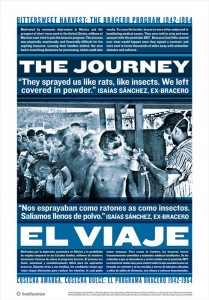
Smithsonian Bracero Exhibit poster – click to enlarge
Photos: Leonard Nadel, Bracero photo courtesy Smithsonian National Museum of American History
Many people are aware that there were labor shortages in the United States during World War II, what they may not know is that to overcome the situation the government initiated a series of agreements with Mexico to recruit guest workers for American farms and railroads. The Emergency Farm Labor Program, more familiarly known as the Bracero Program, brought as many as 2 million Mexicans to the United States for this purpose.
While the work was often grueling, the program offered participants economic opportunity, and the contributions made by these laborers have had significant impact on the political, economic and social climate of both countries, according to the Smithsonian Institution Traveling Exhibition Service (SITES).
This fall the Smithsonian Institution Traveling Exhibition Service is featuring an exhibit about this little-known chapter in American history as its fall 2012 free resource for schools, migrant education centers, museums and libraries. Titled “Bittersweet Harvest: The Bracero Program, 1942-1964,” the exhibit, based on the traveling exhibition by the same name with images and interviews by documentary photographer Leonard Nadel, includes a set of six bilingual posters made this year based on the materials from the exhibition.
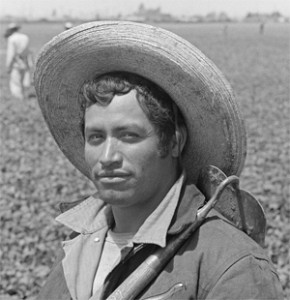
Bracero in the field, 1956
The exhibit was organized by the National Museum of American history in partnership with the SITES, and received federal support from the Latino Initiatives Pool, administered by the Smithsonian Latino Center. The collection will be on display in several states through 2014. Two copies of the same exhibition have visited 10 cities nationally. A list of cities and dates may be found at sites.si.edu/bracero/
“We partnered with University of Texas, El Paso and Brown University and other regional universities to invite former braceros and family to participate,” Steve Velasquez, curator, original Bracero exhibition, explained by email when asked about the selection criteria for the exhibit. “We recorded over 700 interviews. We used the Nadel images as a guide touching on the themes of why they created the program and why they journeyed, what kinds of work did they do, what was the experience like, and what was the legacy of the program in the US. We reviewed close to 200 interviews to use in the exhibit. The poster set is drawn from Bittersweet Harvest exhibit.”
In response to the question about the people and organizations responsible for selection of the project, he said: “We held an advisory meeting in 2005 with other experts in Mexican American history, bracero history, public history, agriculture/labor history, and Latino history. Our partners contributed resources to the collecting of the materials. George Mason University helped create the website braceroarchive.org. At the Smithsonian Institution the curators and educators were Peter Liebhold, Steve Velasquez, Magdalena Mieri, and Bonnie Campbell Lillienfeld. Kristine Navarro and staff from UTEP Matt Garcia from Brown Univ., Sharon Leon from GMU. As well as a host of other institution that provided space to do collecting.”
Little information remains of the program participants today, he explained: “We have no record of how many remain in the US today. The contracts indicate that they needed to return to Mexico at the end of the contract or after 18 months. From our research we know some were sponsored to get work permits and citizenship by growers or married Americans. Some returned later in life. Some went back to Mexico never to return. Some skipped out on the contracts. Many men held multiple contracts.”
The organizers have not decided what will happen to the exhibition when the tour ends. The National Museum of American History collects, preserves and displays American heritage in the areas of social, political, cultural, scientific and military history. The Smithsonian Latino Center is dedicated to ensuring that Latino contributions to arts, sciences and the humanities are highlighted, understood and advanced through the development and support of public programs, scholarly research, museum collections and educational opportunities at the Smithsonian Institution and its affiliated organizations across the United States.
Posted by Elena del Valle on January 18, 2012
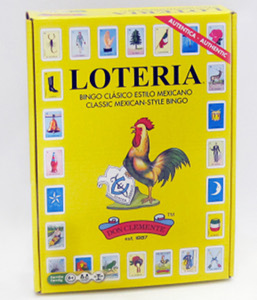
Loteria, a bilingual board game, will be available in the United States in Spring 2012
Photos:G.S. Schwartz & Co. Inc.
Techno Source, a division of LF Products, and FremantleMedia Enterprises (FME), the commercial and brand extension of FremantleMedia, expect to sell to Mexican Americans “hundreds of thousands of units a year” of Loteria, a $5.99 board game that is popular in Mexico. Loteria is Spanish for lottery.
Toward that end and assuming the country’s large Hispanic population will be interested in their new product last month they announced a licensing agreement whereby Techno Source will sell Loteria board games made in Shanghai, China in the United States. The game is expected to arrive at mass and specialty retailers in spring 2012.

Eric Levin, division head, Techno Source
“The primary market for Loteria is the Mexican-American population. It is such an iconic game that anyone with Mexican heritage knows and loves from childhood. Now they can easily buy Loteria for their families here in the USA and pass along this great tradition,” said Eric Levin, division head, Techno Source when asked about the target audience for Loteria. “Additionally, it is a great family game, appropriate for everyone ages 6 and up. It includes English and Spanish translations, so it’s easy for those who are fluent in either language and also a great teaching tool for those who wish to learn. Techno Source has been tracking the growth in the Hispanic population and hearing steady feedback from our retail partners that they are looking to better serve this population in their stores. This was a natural fit and is and great way to bring an extremely well known product to the US market.”
According to promotional materials, Loteria originated in Italy in the 1400s and was introduced to Mexico in 1769 where it became very popular. Loteria is a bingo style game of chance that uses colorful, iconic images of Mexican culture on playing cards instead of numbers on ping pong balls.

Naz Cuevas, senior manager, Consumer Products, FME
“We are excited to work with Techno Source to bring the Loteria family board game with its deep cultural roots and recognizable imagery to families in the U.S.” said Naz Cuevas, senior manager, Consumer Products, FME. “Their marketing expertise and vast distribution network will allow us to reach the young Hispanic market, the fastest growing segment in the U.S. with more than 44 million people, and also broaden the audience for this historic brand.”
Techno Source, a division of LF Products and part of Li & Fung Limited, is one of the fastest growing global toy companies. The Techno Source game portfolio includes 20Q, Tetris, Disney, Rubik’s, Nickelodeon, Bicycle (The United States Playing Card Company), Intellivision, Guess What I Am!, and Electronic Touch-Screen Sudoku.
FremantleMedia Enterprises is a full-service brand building company that specializes in rights management and exploitation across multiple platforms such as consumer products, sponsorships, interactive and mobile, and live events. FME’s portfolio of third-party brands includes Rebecca Bonbon, a girls fashion brand designed by Yuko Shimizu, the original creator of Hello Kitty; Endless Summer, a beach culture and lifestyle brand inspired by the 1964 cult classic film; Condè Nast lifestyle brands Self and Epicurious, and Bellator, a mixed martial arts fighting championship brand.
Posted by Elena del Valle on August 31, 2011

Mercadito Midtown
Photos: TransMedia Group, Mercadito Midtown
Earlier this month, Rock Hard Taco, a Mexican cuisine restaurant with a So-Cal style atmosphere, opened in Boca Raton, Florida (scroll down for the Rock Hard Taco Mahi Mahi Tacos recipe courtesy of Rock Hard Taco). Not too far south in Miami Mercadito Midtown serves creative Mexican cuisine, especially tacos.
The Mercadito restaurant and its sister properties specializing in Latin American cuisine are owned and operated by Mercadito Hospitality, a company that has grown from a first New York City location in 2004 to four restaurants. The company, owned by Alfredo Sandoval, Felipe Sandoval and Patricio Sandoval, has a second restaurant in New York and one Chicago.
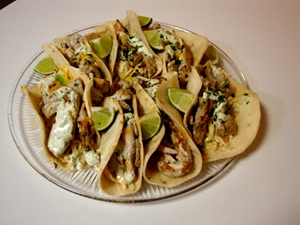
A dish at Rock Hard Taco
What down economy? You wouldn’t know there is a stagnant economy in the country by watching this company’s growth. Mercadito Hospitality, which also owns and operates Double A, an exclusive cocktail lounge next to Mercadito in Chicago, plans to open Tavernita, a second Chicago restaurant, this summer and a second one in Miami this fall. Company executives believe their success can be attributed to the innovative interpretations of traditional Mexican cooking of Chef Patricio Sandoval, and the complex flavored beverages on offer.
At the same time that ethnic food restaurants gain popularity nationwide (see Hispanic, Asian foods booming ) the popular food truck movement in urban areas and television cooking programs nationwide may be the continuing catalyst for at home trial of ethnic foods. It seems there is room for growth in varied ethnic food types, according to Ethnic Foods U.S. January 2011, a Mintel (a research company) survey released earlier this year.
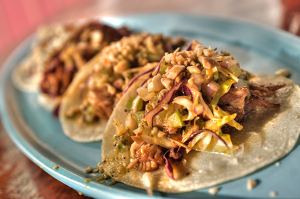
Carnitos Tacos at Mercadito Midtown
The more consumers are exposed to foreign cultures and cuisines the more likely they may be to try preparing some of those dishes at home, especially this year when many families are eating at home frequently due to increases in unemployment and related issues. Mintel analysts believe consumers preparing ethnic foods at home are more likely to be of a nationality or heritage different than that of the food type they are preparing.
For example, although less than 65 percent of the population is Italian 65 percent of survey responders said that they prepared at least one Italian meal at home in the past month. Similar percentages were evidenced for other ethnic foods: Mexican (60 percent), Chinese (42 percent), Spanish/Tapas (17 percent), Japanese (16 percent), Greek (12 percent), Indian (13 percent ), Thai (12 percent), and Korean (8 percent).
Rock Hard Taco Mahi Mahi Tacos
Posted by Elena del Valle on August 12, 2010
Published in a serialized format
By Hilda Luisa Díaz-Perera

Hilda Luisa Díaz-Perera
Salsa is Cuban. The bolero is Cuban. So is a cigar worthy of the name, the Cuba Libre, the mojito and also, believe it or not, the guayabera. I can’t remember life without it. I bought my Chinese-Cuban-American grandson his first guayabera, the tiniest thing, when he was barely a few days old: “Little man” I said, “Welcome to our culture!”
The guayabera is solidly etched in the psyche of a Cuban woman of my generation. I think most of us are emotionally bound to it through memories we hold very dear of fathers, grandfathers, and older family patriarchs wearing them. I can remember the day my then young and very conservative grandfather, finally gave in to my grandmother’s pleas to wear long-sleeved guayaberas instead of sitting through his meals fully suited, in the hot, Cuban weather. I recall my dad sweeping me off the floor as a little girl, smelling his clean-shaven face and feeling his crisply pressed guayabera, double-dipped in thick and gooey homemade yucca starch as he carried me in his arms. I cherish the memories of Sunday afternoons at the Yacht Club watching all the elegant men strolling everywhere in – of course – their guayaberas.
As a young girl growing up in Cuba, I instinctively understood there was magic in the guayabera. Women with men wearing them seemed to be more romantic, sensual, feminine and beautiful in their own summer attire, usually made of light summery fabrics that rustled in the sea breeze. I remember very airy organza blouses and guayaberas; white linen dresses and guayaberas; blue polka-dotted dresses and guayaberas; soft, straw wide-rimmed hats and guayaberas; cigars and guayaberas; a well-groomed gray beard and guayaberas; the aromas of sweet lime-cologne, café cubano (Cuban coffee) and guayaberas; the mojito, a cubilete game and guayaberas; the smell of the ocean permeating Havana evenings and the guayabera.
When I became an adult, and settled in the States, with a husband and young children, I made sure my husband had a guayabera. I think I was probably one of the first young Cuban women who pushed for this very special shirt to be worn again by our men. It was a national emblem that lent us a visible identity during our early years in exile when we were all frantically holding on to our values and traditions which we felt were being threatened by the larger Anglo culture surrounding us. The guayabera became the expression of an emotional need deeply buried in our national memory. In Miami, during the early 70’s, the guayabera gradually gained renewed interest among what were then known as the yuccas (young up and coming Cuban Americans), an acronym derived form the name of the edible root, very popular in the Cuban diet.
But what is the guayabera? The traditional guayabera, originally a campesino or peasant shirt, as we know it today, and as it was finally handed down to us in the first decade of the XX Century, was white and made of fine linen. It was a long-sleeved shirt, with four large pockets, and five rows of very narrow pleats, two running down the front of the shirt and three down the back. The back of the guayabera is said to have been purposely designed to look like the Cuban flag with a triangle resting on the shoulder area and five stripes running down vertically below it. The flaps at waist level on either side had developed earlier to allow for easier handling by the campesino with his machete and hunting knife. Finally, if it is a traditional guayabera, it should also include twenty-seven very small mother-of-pearl buttons.
Origins a little bit of history
Where did the guayabera come from and is there a history behind it? Most of the time, where it concerns popular history, those who have made a difference in the lives of millions of people were never aware of it, and therefore the facts of whatever they contributed to mankind is lost in the jumble of reality, fiction and, in the case of the guayabera, in the fantasy of romance.
According to research conducted by Cuban journalist Pedro Carballo Bernal, several Andalusian and later Canary Island families who settled in Cuba around the Yayabo River, in Sancti Spiritus, began making shirts that would eventually become the precursors or prototypes of today’s guayaberas. More precisely, as the story goes, the first guayabera was made in 1709, by Encarnación Núñez García, an Andalusian wife from the town of Granada, hoping to please her husband, José Pérez Rodríguez, a potter by trade, who requested that she make him comfortable, loose shirts from a bolt of fine Belgian linen they had received from Spain.
These shirts were to be worn over his trousers, have long sleeves, and big, wide front pockets where he could carry, among other things, his smokes or fumas. Since these shirts first became popular in the region of the Yayabo River, which flows through Sancti Spiritus, from west to east, they were first called yayaberas, as were the natives of the area, who at the time were identified as Yayaberas (women) and Yayaberos (men), after the name of the river. Another version of the name guayabera is that men had the habit of filling the wide pockets of their shirts with ripe guayabas or guavas, thus the possible transition of the name from yayabera to guayabera. Ripe guayabas or guavas, with their wonderful but penetrating, pungent aroma, as every other tropical fruit, exude a sugary sap that can easily stain fabrics. I cannot imagine women of the XVIII and XIX Centuries fighting a guava stain without Clorox, Shout, or Wisk. And yet oral tradition around the Sancti Spiritus area supports the guava story:

Very soon, the peasants of the surrounding countryside took to wearing the guayabera and these shirts became popular almost immediately because they were appropriate for work and the hot weather. Townsfolk, however, rejected them as being too coarse and vulgar to be worn by even the lower classes within the town. The fact that this story is so precise seems to diminish its credibility among some historians. I for one believe it could be true since we have no way of knowing what it is that History will decide to save, regardless of how trivial future generations of historians might perceive the information to be.
Researchers also point to the fact that commercial regulations between the Spanish colonies and Spain restricted certain items from being imported into the colonies, linen being one of them. Also, they claim, there were no direct commercial ties between Sancti Spiritus and Spain. But pirates did abound, especially in the Caribbean area, and were quick to offer the shortcut to waiting for the Spanish fleet. Settlers, of course, availed themselves of contraband in order to quickly obtain much needed supplies for their languishing settlements. This could explain the bolt of linen.
Dr. Armando J. Casadevall, a native of Sancti Spiritus, in his article De la chupa a la guayabera universal (From the chupa to the universal guayabera), published in La Voz Libre in Miami in 1998, rejects the Sancti Spiritus origins of the guayabera. He cites stories written about Sancti Spritus by Tadeo Martínez-Moles in 1791, and by Rafael F. Pérez Luna in 1860, as well as the 1866 edition of the encyclopedic dictionary compiled by Jacobo de la Pezuela. Casadevall did not find any references to the guayabera originating in Sancti Spiritus. He even goes as far as stating that there were very few guava plants in the area and that the guayabera was definitely not suitable attire to pick guavas in.
Casadevall says that the word guayabera was not even used in Sancti Spiritus until after the establishment of the republic in 1902 and that the preferred item of clothing among Cuban men in the XIX Century was the chupa, a short shirt with four flaps beginning at the waist and rather tight sleeves, today considered by many as the precursor of the modern guayabera. He goes on to explain that what we identify today as a guayabera was then made of cotton khaki and called camisilla in the 1920’s, when he was a youngster. His father, who was Cuban and apparently proud of his origins and his Cuban ways, was fond of wearing these chupas or camisillas. Casadevall gives credit to a tailor by the name of Ángel Serrano for having introduced the pure white, fine linen shirt called guayabera to the city of Sancti Spiritus in the 1930’s.
These two opposing stories are recorded by history and exist side by side. It is for this reason and for the sake of objectivity that I present them to the reader. Judging from the many articles I have come across, the scale of history seems to tip in favor of the story about the Andalusian couple, Encarnación and Joselillo, and their bolt of linen.
The insurgent guayabera
Ciro Bianchi Ross, writing in the Cuban government-sponsored magazine Juventud Rebelde, points out that this early, and from his point of view “questionable” story about the Sancti Spiritus origins of the guayabera, if nothing else, marks the recognition of the existence of this special shirt and places it within the Cuban historical timetable. He explains that a description of the guayabera is not even present in Cuban literature of the XIX Century, until the 1890’s when author Nicolás Heredia writes about it in his Cuban novel, Leonela. Furthermore, Bianchi Ross says that the Cuban peasant did not wear the guayabera, but rather normally donned a loose blue or striped shirt over his trousers, a straw hat or sombrero de yarey, boots, a neckerchief to wipe off his sweat and his machete.
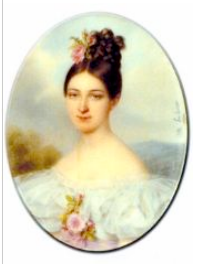
When the Countess of Merlin, (Havana 1789– París 1852), a Cuban aristocrat married to a French count, who is considered the first female Cuban writer, visited Havana in 1840, the guayabera was either not popular yet among the Cuban peasantry around the capital, or it did not go by that name. She does not mention it in any of her well-known writings or in the copious journal she kept of the trip. However, the fact that she does not mention the guayabera, does not mean it did not exist, at least as a prototype.
Guadalupe Yaujar in her article La guayabera cubana, quotes chroniclers of the mid-XIX Century who write that the guayabera existed and was already popular when Narciso López first raised the Cuban flag in the city of Cárdenas on May 19th, 1850. In 1856 or ‘57, Juan Cristóbal Nápoles Fajardo, better known in Cuban literature as “El Cucalambé”, published Rumores del hórmigo, a book of poetry that includes a description of the guayabera and calls it by its present name, establishing him as the first writer on record to acknowledge the existence and use of the guayabera. He became the most quoted and most popular poet of the mid- XIX Century in Cuba, probably helping to disseminate awareness of the guayabera throughout the island. El Cucalambé was honored in 1953 by the Cuban government which chose his birthday, July 1, as the official Día de la Guayabera (Guayabera Day).
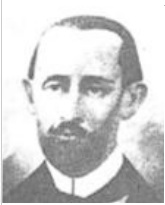
By 1866, in the town of Güines, political reformer and activist Nicolás Azcárate is elected delegate to the Information Council of the Spanish courts or parliament. His followers organized a victory celebration in his honor and it is noted by eyewitnesses that the peasants of the surrounding countryside showed up wearing their classical guayaberas and jipijapa or straw hats. The operative word here is classical since it implies time, design, tradition and the conscious acceptance by a social group that an item of clothing clearly identifies them. Writers also agree that when Carlos Manuel de Céspedes rang the bell of his sugar mill La Demajagua on October 10th, 1868, calling for Cuban independence from Spain, some of the men who joined him were wearing, not the military shirt known then as the chamarreta, as Ciro Bianchi insists they did, but rather one very similar to what is known now as the guayabera.
I do not agree with Bianchi Ross on this fact because it seems incongruous that a group of colonial men, ready to fight the mother country for the freedom of their land, would go to do so dressed in the enemy’s uniform. I tend to think that if they were indeed not wearing a guayabera, they had to be wearing something very similar, a regular light colored, long sleeve shirt or camisa, a striped peasant shirt, or some early guayabera design.
This puts us right in the middle of an ongoing debate as to whether or not the Cuban army used the guayabera during the fight against Spanish colonialism. Many photos still exist showing the Cuban mambí, the name given to the Cuban insurgents in the wars for independence, men like generals Enrique Loynaz del Castillo and Máximo Gómez, commander-in-chief of the Cuban Army, wearing a shirt that is indeed very similar to the guayabera.
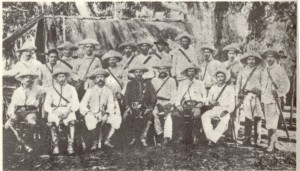
The mambí/mambises or Cuban insurgents in the wars for independence against Spain![]()
The Cuban army had no military uniform and dressed in whatever the men could find. At the start of the last War of Independence in 1895, in his Diario de campaña, Cuban national hero, José Martí, mentions the chamarreta, the military shirt, and not the guayabera. Charito Bolaños, the woman who reputedly sewed for many insurgents during the war, among whom were generals of the stature of Mayía Rodríguez and Mario García Menocal, states that she never sent a guayabera to the manigua, as the rough wilderness where the Cuban army fought against the Spaniards was called. But then, men such as those mentioned above, who could have had clothing sewn especially for them, were probably not going to choose to wear a shirt that was so similar to the one used by the common peasant. It must be remembered that Cuban wars for independence were fought for political independence from Spain, not necessarily for social equality.
María Elena Molinet, Cuban costume designer in charge of important historical films that cover this period of Cuban history, such as Baraguá and La primera carga al machete (The First Charge of the Machete), after collecting and studying many such photos, asserts that none of the Cuban rebels is wearing a guayabera. It must be said, however, that the chamarreta had many details that coincided with the design of the guayabera, such as the long sleeves, the four large front pockets and the side flaps to ease it over men’s trousers. Also, at the onset, the wars began and were fought mainly on the center-east side of the island where supposedly the guayabera already had some, if faint, hold on the peasants. The greater insurgent army was not made up of the rich hacendados or landowners, but rather of the poor peasants and the small town lower classes.
The fact though that the controversy exists, is an indication that the guayabera was probably already competing favorably against very similar shirts used by Cuban men of the XIX Century. It is also possible that as the century unfolded, and the popularity of the guayabera increased, it underwent important changes that improved its design. This in part explains the variations described as well as assertions made by observers of the time, which, as history has it, lend themselves well to fuel further discussion.
A bit of sewing
So, the shirt that would become today’s guayabera was probably first made sometime in the XVIII Century. It then developed gradually over the XIX Century, not as a design made by one person, but rather as the result of the many shirt variations existing in the island and the efforts of several seamstresses and tailors who complied with shifts in taste and fashion by adding or deleting features to the original prototype.
Someone, we cannot identify who, added the collar. Someone else, who surely possessed very high sewing skills, must have thought of adding the narrow pleats with their minuscule stitches down the front and back of the shirt. Then, at some point during the Cuban wars for independence from 1868 to 1898, the design of the Cuban flag was incorporated onto the back of the guayabera.
This idea probably originated from the Cuban insurgents’ habit of wearing Cuban flags, or red and blue handkerchiefs tied together on the backs or fronts of their shirts, along with their religious medals, as a symbol of patriotism. But Spanish authorities declared this practice a form of treason and soon the Spanish soldiers began executing any Cuban insurgent caught wearing a Cuban flag. Some expert hands must have drawn the highly stylized and clever design of the triangle on the shoulder area of the shirt and divided the back into horizontal stripes separated by rows of pleats.
A person deft with needle and thread must have sewn the triangle on. One of the angles of this triangle falls very visibly at the top center of the back, as they do on each front canesú or yoke, and on the top of each pocket of an authentic guayabera. Any error in stitching, or failure to align or fold the fabrics properly would cheapen or ruin the piece. It must have been a very patient person who decided to pepper the shirt with its twenty-seven tiny buttons, and was then willing to sew them on and make 27 buttonholes, all by hand!
Finally somebody must have noticed the wear and tear the flaps were always under and decided to reinforce the bottom edges and side openings. Most writers agree that the traditional guayabera owes much of its success and beauty, not surprisingly, to shirt makers and seamstresses of the Sancti Spiritus area and of another town nearby called Zaza del Medio.

Guayabera maker Ramon Puig and Glenn Lindgren (of The Three Guys From Miami) wearing Puig guayaberas
It is indeed a pity that users who buy guayaberas are unaware of the sewing skills that were required to finally arrive at the design of the guayabera as we know it today. Its early evolution took place in the absence of the precision sewing instruments available to us. I was taught to sew by my grandmother, who learned the craft as a young girl working with her father, a Spanish tailor who established his shop in the city of Havana in the 1920’s.
Among many other sewing skills, she taught me how to make tiny buttonholes by hand. It is a painstakingly slow, careful process that of making tiny stitches that must fall one after the other in a horizontal row to secure the fabric underneath. One hand crunches over the small needle and thread; the other must hold the opening still, in order to avoid stretching at the edges of the cut fabric, in this case, fine linen, which, with the well defined warp and woof of natural fibers, ravels easily and would render a sagging and crooked buttonhole. I never qualified, for lack of patience and dexterity, to make twenty-seven of those buttonholes in a row! I’m glad my grandmother also taught me Math!
The final touch came after the guayabera was finished. Experienced pressers where required to press the seams, pleats, buttonholes and folds into place. Later, when the guayabera had to be washed, a home-made starch was concocted from boiling water and grated yucca that was then strained and allowed to cool. The starch was more or less diluted with water depending on the user’s preference. The guayabera would be dipped into the mixture once or twice and then hung to dry. After it dried, the laundress would sprinkle water on the stiff sun-dried shirt and then wrap into a bundle until it was time to press it. I wonder if Ramón Puig, famous for his guayabera store, uses Niagara starch today. I do!
La Guayabera in the XX Century
As the guayabera became more popular, each region in Cuba gave it its own name. In Camagüey province, it was called camagüeyana; along the trocha or military divide during the wars for independence, it was known as trochana; in the town of Manzanillo, it was manzanillera; it was guayabana around the city of Havana, where it is said to have adopted the shirt collar for elegance. Today, although on the world stage it goes under the name of guayabera, there are many places where it is known as habanera and cubanita or little Cuban.
The guayabera came into its own during the XX Century. Cuban peasants were already wearing it and the politicians started using the guayabera during their campaign tours in the countryside. Soon it became the shirt of choice in the popular dance academies in Havana. For more formal occasions, a bow tie was added. Gradually, as more prominent men became followers, the guayabera was able to gain entrance into the most exclusive places and even official government ceremonies.
The earliest graphic testimony available of the guayabera is from 1906, even though the word guayabera is not formally legitimized as a Cuban noun specifically naming the shirt until 1921, when a man by the name of Constantino Suárez included it in his book Vocabulario cubano or Cuban Vocabulary, identifying it as attire popular among the peasants in the countryside.
The guayabera, in this final and now considered “traditional” version, first conquered the towns in the provinces. Then in 1908, during the government of General José Miguel Gómez, coincidentally a native of Sancti Spiritus, it finally gains access to Havana. After the fall of the Machado dictatorship in 1933, and due also in part to the Crash of 1929, there is a shift in social attitudes and customs that allows for a more relaxed dress code, which in turn helps open higher social possibilities for the guayabera.
President Carlos Mendieta, apparently decreed the guayabera as the national shirt sometime during his short administration which lasted from 1934 to 1935, but that document has never been found. Bianchi Ross argues that the same happened to the danzón, an early XX Century Cuban dance form widely followed in Latin America, and no one questions its origins. President Grau San Martin, who comes to power in 1944, implementing widespread social reforms under the Partido Auténtico, which also supported the symbolism of Cuban national identity, adopts the guayabera as his favorite shirt.
Even though later, his successor, President Carlos Prío Socarrás, bans it as inappropriate attire for official government business, the impetus given to the guayabera during the Grau administration is strong enough to trigger the next stage in its development: an amazing explosion of popularity without historical precedence; that took all the Cuban department stores and clothing warehouses by surprise, turning them, observes Isabel Fernández de Amado Blanco, a contemporary journalist, into guayabera showcases; so much so, that in 1948 a symposium was held in Havana at the prestigious Lyceum Lawn and Tennis Club, to discuss the use and abuse of the guayabera.
The humble shirt of the legend of Encarnación and Joselillo had arrived and was quickly altering the Cuban way of life as it had been known up to that point, threatening to displace all other forms of masculine attire. One of the discussions at the symposium centered on identifying under which circumstances and at what times during the day or evening, the wearing of guayaberas could be considered appropriate!
In the 1960’s, the guayabera left Cuba as so many of us did and went into exile in the Yucatan Peninsula and in the State of Florida. Close trade relations between the island and the Yucatan were ongoing since colonial times, well before the advent of Castro and his Revolution. The guayabera settled in these logical choices of destination since wealthy Yucatecan Mexicans used to purchase them in well-known pre-Castro department stores such as El Encanto and Fin de Siglo, or in establishments specializing in the manufacture of guayaberas, one of them being Ramón Puig, who among several others, has been producing them in the City of Miami for the last quarter century.
Because they could not obtain the guayabera in Cuba anymore, the Yucatecan Mexican entrepreneurs decided to begin manufacturing the shirt in the city of Merida, which advertises itself as “the capital of the guayabera.” These guayaberas are probably the ones that have come to be known, maybe incorrectly, as the “Mexican wedding shirt.” The guayabera also found its way into the textile industries of Colombia and Panama in our continent, and of China and the Philippines in Asia, where new fabrics, colors and designs have been developed, and where, in the case of China, the guayabera is manufactured very inexpensively to the detriment of its quality and elegance.
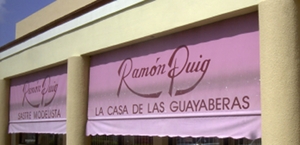
It has also severely undercut the Yucatecan industry. On the other hand, Ramón Puig, who considers himself a Spaniard from Sancti Spiritus, has been making Cuban guayaberas for the last 59 years, 25 of them in Miami, Florida. Among his influential clients were Ernest Hemingway in Havana, and Ronald Reagan, Silvester Stallone, Robert de Niro and many others in the United States. According to the article, “The rise of the guayabera in cutting edge fashion,” written by Enrique Fernández of The Miami Herald, as published in Havana Journal, “Puig’s custom guayaberas start at $350 and can reach $600, depending on the cloth and size of the client. Off-the-rack linen or cotton long-sleeved garments sell for $80. Puig’s store sells about 80 guayaberas a day.” And he can’t keep up. Fernández describes it (and I quote): “The real guayabera. Not the short-sleeved poly-blend shirt South Beach youths wear. Irish linen or Egyptian cotton. Always long-sleeved, preferable custom-made. Embroidered initials. Needless to say, pricey.”
Fine linen, no matter its origins, the long sleeves, the color white, and precision sewing, including embroidering one cuff or one pocket with the owner’s initials, have always marked the elegant guayabera since the 1930’s, and although now these details might be perceived as signals of a resurgence of the shirt, that mark a new direction away from the cheap Chinese and Filipino versions available to common or less refined tastes, the guayabera took a good 300 years to reach its fineness and I for one tend to reject some of its more common, tacky second cousins.
The guayabera can be very flexible and eager to please. I am not in the market for a $600 guayabera or, for that matter, for the $350 one either! Luckily, for most of us, there exist affordable, fine, well-made guayaberas to purchase and wear proudly. I counted just in case, and mine even has all the 27 buttons!
For almost all of those 300 years of existence, the guayabera remained a Cuban thing, known and worn by Cubans and those familiar with the Cuban cultural heritage and the Cuban way of life, be they natives or foreigners. It is probably through Hollywood movies and mass communications and other similar venues, that it reaches the world stage in the ‘30s, ‘40s’, and ‘50s. In recent years most Cuban musicians and actors as well as other Caribbean entertainers have adopted the guayabera, because it stands for the romance and the mysterious aura surrounding anything Cuban, as well as for tropical living in general. Many Latin American countries especially those in the Caribbean basin claim the guayabera as their own, but it is only Cuba that can really trace its origins in the island.
The guayabera was nimble enough to jump across all sorts of boundaries, physical, social and emotional, and to become a favorite piece of clothing in the most unlikely places of the globe. We must remember that until 1959, Cuba was accessible to one and all. It gave unselfishly of its culture and the world partook of it. The pre-1959 guayabera traveled freely to Mexico, Puerto Rico, Panama, the Dominican Republic, Japan and the Philippines, as did Cuban orchestras and entertainers whose work helped spread Cuban culture and heritage around the globe.
Thus we find guayaberas in China, in Egypt, in Japan, and even Africa, where, in the mid 70’s, under the Castro regime, it is possible that Cuban soldiers brought them along when they went to fight in Angola. Compay Segundo and The Buenavista Social Club must be given credit not only for having recaptured rhythms and songs of early XX Century Cuban music. Although they were older musicians, they rejuvenated and re-established the guayabera around the world. By using it onstage they became models to potential users, placing it within the context of a traditional, respected art form, joy and celebration.
Lately, we have seen its popularity soar as many Latin American heads of state wear them to regional conferences and meetings, lending the guayabera undeniable recognition as a shirt of preference among the very conservative ruling elites. Who else has been seen in his guayabera? Emilio Estefan, Danny Glover, Prince Albert of Monaco, Sting, my very special American friend Bob Anders to whom my husband and I gave one, and many, many more!
Afterword
Interestingly enough, as I was doing research for this piece, I came across several articles written by Cuban researchers living in Cuba that bemoan the fact that younger generations of Cubans raised in the island were not interested in the guayabera, did not wear it and considered it attire only for older men. Coincidentally, then, as the guayabera was becoming more popular among the younger Cuban generations that went into exile, the opposite was true in Cuba, where the use of the guayabera waned, partly because with the revolution, it somehow became tied to the government’s definition of corrupt politics and politicians, and the so-called “decadent” way of life of pre-Castro Cuba.
Probably a better reason is that as the Cuban revolution implemented its communist economic policies, which included the taking over of all of the means of production and distribution, such as the textile industry and all of the existing department stores, the country became immersed in years of scarcity and dearth during which very basic materials like cloth and thread to make guayaberas, were not readily available. Another reason very prevalent in the late 60’s, 70’s and 80’s, probably still valid today, helps explain this rejection of the guayabera among other Cuban patriotic symbols, especially that of national hero José Martí: unhappily, it was probably the only way that the Cuban youth, trapped by a Marxist system, as many believed they were, could quietly reject a revolution which insisted on ramming political indoctrination down their throats disguised as patriotism.
José Aurelio Paz was probably one of the first Cuban writers in the island to identify the negative attitude towards the guayabera evident among Cubans living in Cuba. In his article for Juventud Rebelde, he suggests that they should recapture the pride of wearing the guayabera and shed the shame associated with it, which is understood as the corrupt government bureaucrats and politicians of the pre-Castro era. But, although he identifies shame as one of the reasons for its lack of popularity among the younger generations, he doesn’t define very successfully the source of that shame. He goes on to say that whereas the guayabera came forth from the working classes and was once available at prices easily affordable by the common man, nowadays it is only available in commercial establishments limited to tourists, at prices too high to fit the skinny national salaries.
One supposedly Cuban online store I checked, TurismoenCuba.com uses the slogan “Powered by Amazon.” All of us who have had a business on the internet know what that refers to. Prices go from $24.99 to $55 US dollars, an amount difficult to come up with by a common working class Cuban who, unless he or she is employed in the tourist industry, his salary does not even come close to $20 Cuban pesos a month. But, of course, this Cuban online store, is not for Cubans inside the island who don’t have ready internet access or credit cards to purchase over the internet. Cubans in Cuba who want to buy a guayabera will not be able to do so in any store within their reach. And yet, guayaberas are available in the government-sponsored stores for foreigners (such as Cubans in exile and their families who visit the island), tourists, diplomats and the privileged of the Cuban ruling elite.
The government-sponsored online store that offers Cuban-made products, Mallcubano.com, does not even include a guayabera in its online catalog. Oh! And one note of irony here: “mallcubano”, pronounced in Spanish, sounds like mal cubano which means “bad Cuban”, “Cuban malady” or “Cuban evil”, but none of them good… Um, I wonder who came up with such a name?
In order to rescue the dwindling interest in the guayabera evident inside Cuba, writer Ciro Bianchi Ross along with Carlos Figueroa Crespo and others, suggested the establishment of The Socio-Political Project of The Guayabera within The Provincial Historical Museun of Sancti Spiritus. The Project already includes guayaberas donated by a roster of politically slanted though undoubtedly significant and historically prominent people of the last 50 years. They are the distinguished famous or infamous, depending on which side of the political divide you belong to, or how objective you manage to stay as you read this list, since, of course, donations of guayaberas by the political center and the political right are non-existing. The list includes, Fidel and Raúl Castro; Hugo Chávez, who donated his red guayabera, a gift from Inacio Lula da Silva, President of Brazil; Colombian and Guatemalan writers, the Nobel laureates Gabriel García Márquez and Miguel Ángel Asturias; Shafick Handal (1930-2006) Secretary-General of the Communist Party of El Salvador; the Puertorrican independentists Rafael Cancel Miranda and Filiberto Ojea, and world renowned Cuban ballerina Alicia Alonso, as well as many others of the political left.
It begs the question, are these personalities who have been given the task of “uplifting” the pride and honor of the guayabera, and of redefining one of Cuba’s most endearing symbols by uncoupling it from the pre-Castro imagery of “corrupt politicians” and then re-associating it with their own supposedly pristine Marxist values, up to the challenge? Can they actually sway the minds of thousands who can finally see beyond the party line, but are still not able to purchase a half-way decent guayabera, in their own native Cuba?
One thing is certain: Miami, the capital of the Cuban exile, may or may not have a guayabera museum and although I think it is a terrific idea, the fact is that we could establish one not because we are not interested in the guayabera, but rather because we have made it popular in the most unexpected places and seen it escalate the loftiest of scenarios. There are guayaberas for all tastes and pocket sizes, and we certainly are not ashamed to wear one. National symbols are not responsible for the actions of irresponsible greedy politicians no matter where they fall within the political spectrum. A reminder: the next time you find yourself close to a guayabera, if you are Cuban, do this: run your fingers over the deftly sewn back pleats that together make up the Cuban flag!
The author holds a M.A. from the University of Miami. She is a free-lance writer and the editor of http://jose-marti.org and http://unacuartilla.wordpress.com.
Editor’s note: Ramon Puig photos courtesy of Three Guys From Miami™
Sources:
La guayabera por María Argelia Vizcaíno
http://jose-marti.org/jose_marti/simboloscubania/guayabera/laguayabera/01laguayabera.htm
La guayabera cubana
http://www.radiohc.cu/espanol/a_sugerencias/2010/jun/guayabera.htm
La guayabera en el Cocodrilo Azul
http://cocodriloazul.blogcip.cu/2009/10/24/la-guayabera/
Verdad y mentira de la guayabera cubana
http://www.juventudrebelde.cu/columnas/lectura/2010-05-22/verdad-y-mentira-de-la-guayabera/
El origen de la guayabera
http://lecturas.cibercuba.com/lecturas/artes/el_origen_de_la_guayabera.html
Por qué la guayabera es puramente cubana
http://www.autentico.org/oa09148.php
García Márquez dona guayabera a museo
http://www.larepublica.pe/cultural/13/04/2010/garcia-marquez-dona-guayabera-museo-cubano
Chávez dona guayabera que le regaló Lula
http://www.7medios.com/index.php/2009/10/19/chavez-dona-guayabera-que-le-regalo-lula-a-institucion-cultural-cubana/
Museo cubano atesora guayaberas de personajes famosos
http://spanish.china.org.cn/international/txt/2010-04/25/content_19901930.htm
Guayaberas impopulares y escasas en Cuba
http://www.turismoencuba.com/Guayaberas-impopulares-y-escasas-en-Cuba_i718.html
T-Shirts, Guayaberas y algo más
http://www.turismoencuba.com/T-shirts-Guayaberas-Cubanas-y-algo-mas-_i197.html
¿Por qué se le puso guayabera a esa prenda de vestir?
http://www.desdecuba.com/mason/?p=1613
Contrapunteo Caribe entre el liqui-liqui y la guayabera por Juan Jorge Álvarez Sánchez
http://www.delagracia.de/san_1.htm
La Guayabera por Hilda Anaya Sotelo
http://es.shvoong.com/humanities/1810175-la-guayabera/
Diferencia entre la guayabera yucateca y la guayabera cubana
http://www.guayaberas.com.mx/articulos/la-guayabera-se-origino-en-cuba/
María Elena Molinat
http://www.opushabana.cu/pdf/MA-2008/Maria_Elena_Mollinet.pdf
La diferencia entre la guayabera yucateca y la guayabera cubana
http://www.guayaberas.com.mx/articulos/diferencia-entre-la-guayabera-yucateca-y-la-guayabera-cubana/
Mallcubano.com
https://www.mallcubano.com/men_207categ.html
Comments:
Filed Under:
Posted by Elena del Valle on December 11, 2008

Mixplay website page – click on image to enlarge
Photos: Mixplay
Mixplay, a video portal owned by Claxon and designed for Spanish speakers in Latin America, Spain and the United States, is 18 months old this month. Since it was established in May 2007 it has had a 250 percent growth in online traffic.
Mixplay users, who range in age between 17 and 35, rely on the website to complement their traditional television programming consumption. Mexico is the top country of origin for the portal followed by Argentina, Colombia, Chile, Peru, United States, Brazil, Uruguay and Spain.
According to a press release, the website is developed 100 percent in Latin America. It is especially designed for new devices and users that want complete control of what, when and where to enjoy the portal’s professionally produced video content.
Mixplay offers visitors videos in the following categories: Music, Prediction, Women, Children, Men, Entertainment, Sports and TV Channels (mainly those produced by Argentinian company Cuatro Cabezas and BBC documentaries).
There are also in-house productions of guitar workshops, video horoscopes and tarot, stories, magic tricks, experiments for kids, as well as exclusive interviews, show coverage, and how to apply make up videos. The programs are produced with Studio Web TV, a 360 degree format that is compatible with Internet requirements as well as digital TV and mobile devices.
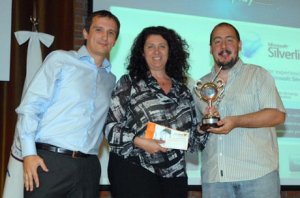
A Mate.ar representative with Mixplay staff members Patricia Tomasini and Cristian Betti
“The video content industry evolves alongside new media offering a publicity evolution,” said Patricia Tomasini, marketing and content manager of Mixplay. “Our growth demonstrates that Spanish speaking users incorporates multimedia content as a new entertainment format that, unlike traditional media, allows users to decide the best time and place to consume it.”
Launched in May 2007, Mixplay offers an online forum for the distribution of in-house and third party audiovisual content in the region. It is backed by Microsoft and Intel. Ad revenue provides financial support for the website, allowing visitors subscription free access to the portal. Company executives plan Video On Demand (VOD) and Pay Per View (PPV) subscriptions and packages for the future.
Mate.ar recently recognized the company with an award for innovative technology and audiovisual content. More than 3,000 websites were considered as part of the awards process. Mixplay was recently redesigned with Microsoft Silverlight technology and now offers a new user inter phase format.
Find out what multicultural kids across America think
Listen to Michele Valdovinos, SVP, Phoenix Multicultural in
“Marketing to Multicultural Kids” audio recording

Michele Valdovinos gives a presentation and participates in an extended Q&A discussion about multicultural children based on a Phoenix Multicultural and Nickelodeon study of 1,300 multicultural children in 16 United States markets.
Find out about
• The Phoenix Multicultural Kids Study
• Relationship between children and their context
• Issues relating to family, technology and media, diversity, buying power, relationships in household, self perception, values, acculturation, cultural heritage, frequency of media activity, income and spending, brand preferences, the American Dream
• How many billions of dollars buying power multicultural kids children have
• Children’s spending attitudes, habits by ethnicity
• How much money a year Hispanic kids have available to spend
• Types of products Hispanic kids buy
Click here for information on “Marketing to Multicultural Kids” audio recording
Posted by Elena del Valle on September 11, 2008

Ernie Allen, president and CEO, NCMEC
Photo: National Center for Missing & Exploited Children
In an effort to reach Spanish dominant communities with a strong online presence, the NetSmartz Teens website NSTeens.org, an Internet safety resource of the National Center for Missing & Exploited Children (NCMEC) with funding support from Sprint, recently added Spanish language information to the site’s online materials.
Project leaders relied on research from the Pew Internet and American Life Project that indicates 76 percent of bilingual Latinos and 32 percent of Spanish-dominant Latinos use the Internet. The new Spanish translations are designed to reach this audience with online safety resources using Web comics, animated videos and activity cards.
The website, created by staff at NCMEC’s NetSmartz Workshop, was designed to educate tech oriented youth about the potential risks they may encounter online and the importance of following safe behavior on the Internet. Now in its second year, the program’s online resources pages target tweens (youth ages eight to 12), their parents, guardians and educators with information about cyberbullying and social networking.
“We know that talking about the potential risks our children face online can be difficult for everyone, but education is critical to all of our online safety efforts,” said Ernie Allen, president and chief executive officer, NCMEC. “No audience should be overlooked, and we are grateful to Sprint for sharing our commitment to reaching as many people as possible with tools they can use to make their families safer.”
To promote the Spanish language content the National Center for Missing and Exploited Children is planning an online outreach campaign targeted at various websites and parenting publications with banner ads in Spanish directed at children and parents. Additionally, Sprint plans to reach out to local Hispanic Chambers of Commerce of which the company is a member requesting that the organizations notify their members about the availability of the Spanish language information.
Sprint committed $395,000 for the second year of its partnership with NCMEC. The funds are earmarked to enhance the project and develop new content. According to promotional materials, all existing content is available in Spanish in the En Español section of the website. Organizers also plan future content in the coming months in Spanish and English on some of the potential future consequences of online actions and the issues associated with online gaming.
Find out what multicultural kids across America think
Listen to Michele Valdovinos, SVP, Phoenix Multicultural in
“Marketing to Multicultural Kids” audio recording

Michele Valdovinos gives a presentation and participates in an extended Q&A discussion about multicultural children based on a Phoenix Multicultural and Nickelodeon study of 1,300 multicultural children in 16 United States markets.
Find out about
• The Phoenix Multicultural Kids Study
• Relationship between children and their context
• Issues relating to family, technology and media, diversity, buying power, relationships in household, self perception, values, acculturation, cultural heritage, frequency of media activity, income and spending, brand preferences, the American Dream
• How many billions of dollars buying power multicultural kids children have
• Children’s spending attitudes, habits by ethnicity
• How much money a year Hispanic kids have available to spend
• Types of products Hispanic kids buy
Click here for information on “Marketing to Multicultural Kids” audio recording
“We are so pleased to be continuing our partnership with NCMEC to fund NSTeens, particularly now that we’re able to bring these materials to an even wider audience,” said Debby Ballard, director of Community Relations for Sprint. “At Sprint, we’re committed to finding ways that we can all work together to provide the best opportunities for our children. The Internet is an important tool from which many youth can benefit but it’s also a tool that’s seeing an increasing number of dangers. NSTeens.org gives our children the information they need to start making smarter choices online and in the real word, in ways that are both fun and meaningful for them.”
NSTeens.org is part of Sprint’s 4NetSafetySM program which offers online safety information for children, especially tweens, as well as teachers, parents, guardians and other adults. Sprint Project Connect provides all 4NetSafety funding. Sprint Project Connect is Sprint’s phone recycling program which accepts wireless phones and accessories of any make and model, and from any carrier.
The National Center for Missing & Exploited Children is a 501(c)(3) nonprofit organization. Since it was established by Congress in 1984, the organization’s toll-free 24-hour national missing children’s hotline has handled more than 2.3 million calls. It has assisted law enforcement in the recovery of more than 128,750 children. The organization’s CyberTipline has handled more than 600,000 reports of child sexual exploitation and its Child Victim Identification Program has reviewed and analyzed more than 14,750,000 child pornography images and videos.
Sprint Nextel offers wireless and wireline communications services to consumers, businesses and government users. Sprint Nextel has two wireless networks serving nearly 52 million customers at the end of the second quarter 2008; industry-leading mobile data services; instant national and international push-to-talk capabilities; and a global Tier 1 Internet backbone.
Reach Hispanics online today with
“Marketing to Hispanics Online” audio recording
Identifying and characterizing the booming Hispanic online market



Joel Bary, Alex Carvallo and Matias Perel
Find out about
• The 16 million Latino online users
• Latino online users by gender
• What they do online
• Their language preferences
• How to reach Hispanic urban youth online
• What affects their online behavior
• What influences their purchases
Click here for information about “Marketing to Hispanics Online”
Posted by Elena del Valle on August 29, 2008
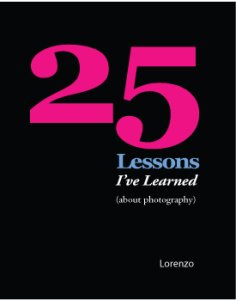
25 Lessons book cover
Photos: Lorenzo Dominguez
Lorenzo Dominguez, a photographer, recently published 25 Lessons (Blurb Publishing, $39.95), a 130-page book about his life illustrated with 500 photos, almost all in color. In this first book he traced his journey from a stifled suburban husband and father, through the breakdown of his marriage and his refuge in a little church in Manhattan.
For three months he swapped caretaker duties for accommodations, living simply and by himself at the church. The stay provided him an opportunity to examine his life. He took advantage of his time by photographing New York City at night. This brought to his mind some of life’s lessons which he shared in the book.

Lorenzo Dominguez, author, 25 Lessons
“I wholeheartedly attribute much of the verve, the passion and the extraordinary appreciation I have for life to my Latin heritage. With 25 Lessons, I’ve attempted to convey much of this both through my words and photography,” said Dominguez. “I can sum up my philosophy about my art, my work and how I live my life in general with a traditional Spanish toast I like to propose whenever I am out, enjoying the company of my friends, ‘Al amor, dinero, salud, y el tiempo para gozarlos todos.'”
In the book, Dominguez shares his secret to the art of living and the simple rules of photography. He meant for the book to be inspirational and poetic; and to spark readers’ creativity, and reawaken their passion for life.
Dominguez grew up in California until he was 24, coming into contact with many Mexican Americans. In 1992, he moved to New York City to attend graduate school. There he encountered a different kind of Latin culture through new friends and neighbors of Puerto Rican, Dominican, Colombian and Cuban background.
He is a director of marketing and communications at a Fortune 500 company in New York City. He is a resident of Manhattan’s Upper West Side.
Dominguez is a graduate of the World Arts and Culture program at the University of California at Los Angeles, and a graduate of the School of International and Public Affairs program at Columbia University. His photography has been featured in fotoMagazin, a German photo magazine, and in 275 blogs, websites, and print publications.
“Moving Beyond Traditional Media Measurement: measuring conversations and social media” audio recording

Presenter Katie Delahaye Paine, founder, KDPaine & Partners
Find out about
- Issues affecting online public relationships today
- Testing relationships as part of a survey
- Measuring ethnic group relationships
- Measuring foreign language communications in a similar ways to English
- Biggest challenges measuring conversations and social media
- Measuring online relationships with little or no money
Click here for information on “Moving Beyond Traditional Media Measurement”
Comments:
Filed Under: Books
Posted by Elena del Valle on July 30, 2008
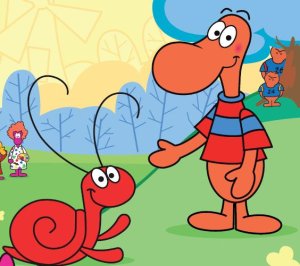
Bertrum and Raimundo
Photos, video: Giddy Gander Company
In an effort to support bilingual (Spanish-English) fluency in the United States beginning with children and children’s television, the Giddy Gander Company launched a cartoon series and brand called The Wumblers in early 2007. Success soon followed. So much so that beginning July 2008, the bilingual branded program is airing on Spanish language television. Scroll down to watch a promo video about The Wumblers.
Also, The Wumblers products will be sold at Walmart through a joint promotion, between The Wumblers, the National Watermelon Association, and Walmart. The promotion was due to begin this July in one of the retail merchant’s Texas stores.
The Wumblers main characters are Bertrum, a young Wumbler, and Raimundo, a bilingual Latin American snail, who are best friends. Bertrum was created to reflect the cultural issues of the toddler children who watch the series. Raimundo is Bertrum’s conscience, mentor, and best friend, even if he is a Spanish speaking snail.
Bertrum’s other imaginary friends show up to advise and tempt him at important moments. He has two loving parents, one of which runs an ice cream shop; and an “eccentric aunt” who likes to paint and sing.

A Wumbler is Born
“The idea is to help Spanish speaking children in the United States achieve English fluency in a new and innovative way while remaining consistent with the values that remain key to the strong family ties and cultural origins of this flourishing community that offers so much to our U.S. society,” said Laura J. Wellington, creator of The Wumblers.
I really believe that it’s time for someone to look up and give Hispanic-Latino children the recognition and heroes they deserve within mainstream U.S. television (and subsequent platforms) with a thrust that warrants the continued emergence and positive contributions made by the Hispanic-Latino people to U.S. (and global) society.”
The Wumblers began as a cartoon series on television nine months ago. The success of the concept is reflected in the recent promotion with Walmart and the National Watermelon Association as well as the production of DVDs that became available for retail purchase this month.
The Wumblers, multi-colored, bulbous-shaped characters, are born from watermelons and eat food that falls from the sky. They are the creation of Wellington, a preschool teacher, mother of four, and widow. In 2006, she co-founded the Giddy Gander Company LLC to respond to requests for The Wumblers.
Find out what multicultural kids across America think
Listen to Michele Valdovinos, SVP, Phoenix Multicultural in
“Marketing to Multicultural Kids” audio recording

Michele Valdovinos gives a presentation and participates in an extended Q&A discussion about multicultural children based on a Phoenix Multicultural and Nickelodeon study of 1,300 multicultural children in 16 United States markets.
Find out about
• The Phoenix Multicultural Kids Study
• Relationship between children and their context
• Issues relating to family, technology and media, diversity, buying power, relationships in household, self perception, values, acculturation, cultural heritage, frequency of media activity, income and spending, brand preferences, the American Dream
• How many billions of dollars buying power multicultural kids children have
• Children’s spending attitudes, habits by ethnicity
• How much money a year Hispanic kids have available to spend
• Types of products Hispanic kids buy
Click here for information on “Marketing to Multicultural Kids” audio recording
Comments:
Filed Under: Video
Posted by Elena del Valle on May 8, 2008

Click on image to enlarge
Photo: starMedia
French owned starMedia continues to reach out to Latinos in the Americas. It recently launched starMedia EntertaiNEWS, the first of three new channels it plans for this year. The new portal is an online channel designed to bring Spanish-speakers in the United States global entertainment news and programming. Developed with C3 Entertainment, the portal recaps the week’s most important entertainment news and lists information about concerts, movies, theater and other cultural events.

Juan José Nuñez, COO, starMedia
“As a subsidiary of one of the world’s leading media organizations, starMedia accesses an extraordinary variety of content. That allows us to continue developing and introducing a new generation of services and resources for our users and advertisers,” said Juan José Nuñez, chief operating officer, starMedia. “StarMedia EntertaiNEWS is the first of a series of new offerings we look forward to launching over the next few months. StarMedia continues to affirm its market leadership position by introducing diverse and relevant content for its U.S. Hispanic audience. We’re totally committed to empowering our users with information and entertainment they value.”
Visitors to the new website can also watch movie previews and other video clips; peruse celebrity photos of the week; and receive entertainment reports. StarMedia plans a weekly a headliner show, a humorous five-minute news Webisodio or webcast sponsored by Toyota. A video capsule features popular entertainers, box office trailers, interviews and celebrity news and gossip.
StarMedia.com is a free-to-web service connecting three million Spanish-speakers online in the United States and 24 million overall. StarMedia has local operations in Mexico, Spain and the United States (Los Angeles, Miami and New York). Orange, starMedia’s parent company, is a subsidiary of the France Telecom Group. C3 is a privately-held entertainment company founded in 1959.
Find out what multicultural kids across America think
Listen to Michele Valdovinos, SVP, Phoenix Multicultural in
“Marketing to Multicultural Kids” audio recording

Michele Valdovinos gives a presentation and participates in an extended Q&A discussion about multicultural children based on a Phoenix Multicultural and Nickelodeon study of 1,300 multicultural children in 16 United States markets.
Find out about
• The Phoenix Multicultural Kids Study
• Relationship between children and their context
• Issues relating to family, technology and media, diversity, buying power, relationships in household, self perception, values, acculturation, cultural heritage, frequency of media activity, income and spending, brand preferences, the American Dream
• How many billions of dollars buying power multicultural kids children have
• Children’s spending attitudes, habits by ethnicity
• How much money a year Hispanic kids have available to spend
• Types of products Hispanic kids buy
Click here for information on “Marketing to Multicultural Kids”










































